Samsung Galaxy Tab Pro 8.4 and 10.1 Review
by Jarred Walton on March 22, 2014 9:30 PM ESTLCD Testing: A Feast for Your Eyes
Let’s start out the testing by going straight to the biggest draw with the Galaxy Pro tablets: the WQXGA displays. Even without testing, I could see by looking that the colors on the Pro 10.1 looked a bit better/more natural than on the Pro 8.4, but I was curious to see if the colors were truly accurate or merely not as oversaturated. Depending on your display setting, it’s a little of both.
I tested the Pro 10.1 in four modes (“Auto”, Dynamic, Standard, and Movie), and contrary to what I’ve seen reported elsewhere, the Movie mode resulted in the most accurate colors. Most tablets and laptops often use white points that are far too hot (blue), and that applies to the 10.1 on the Dynamic and Standard modes, though Standard is a bit better perhaps; it also applies to the Pro 8.4 display. The Movie mode on the other hand clearly reduces the saturation levels and ends up being very good overall. Here are five sets of galleries showing the testing results for the various display modes on the 10.1 as well as the sole mode on the 8.4.
As for brightness, contrast, and DeltaE results, both models do reasonably well, again with the color accuracy advantage going to the 10.1. Keep in mind that the only other tablets in these charts just happen to be some of the best displays on the market, with the iPad Air being factory calibrated and the Nexus 7 being one of the best non-Apple devices in terms of color accuracy.
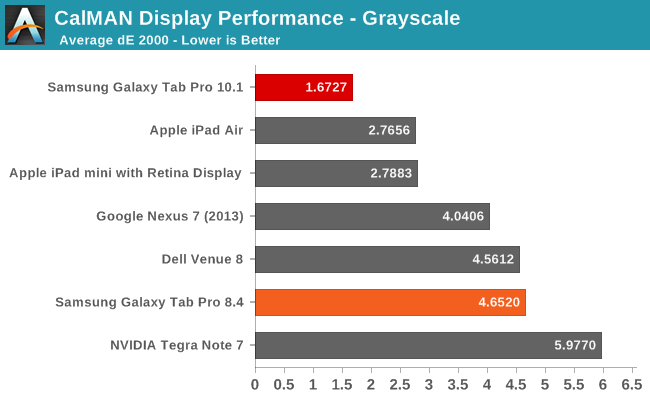
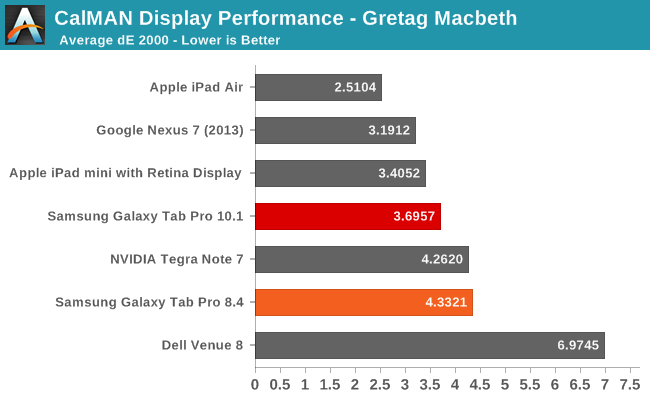
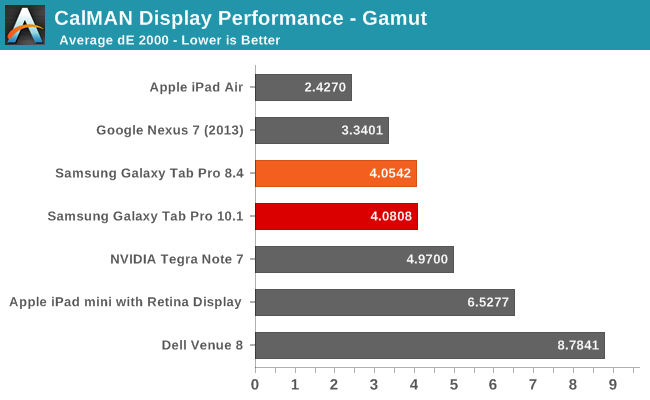
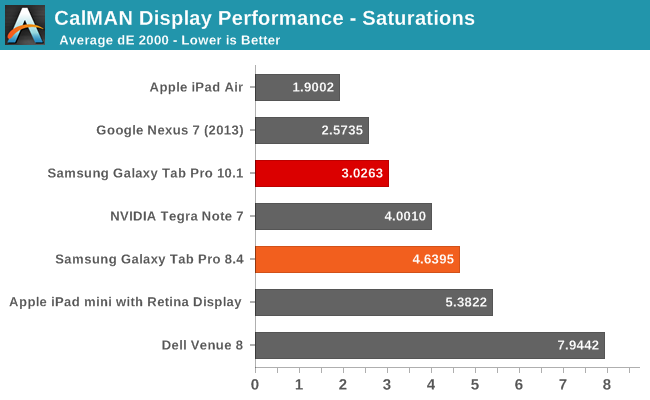
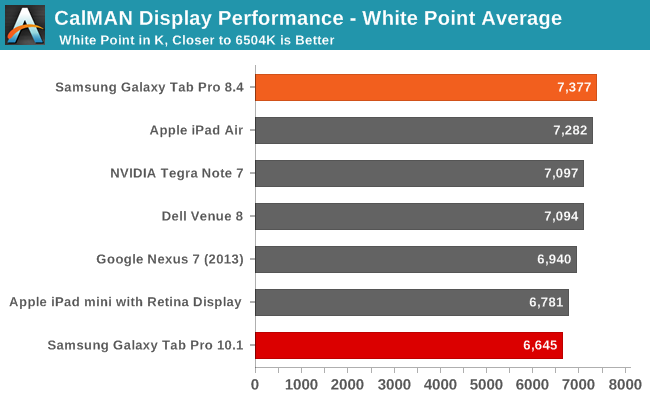
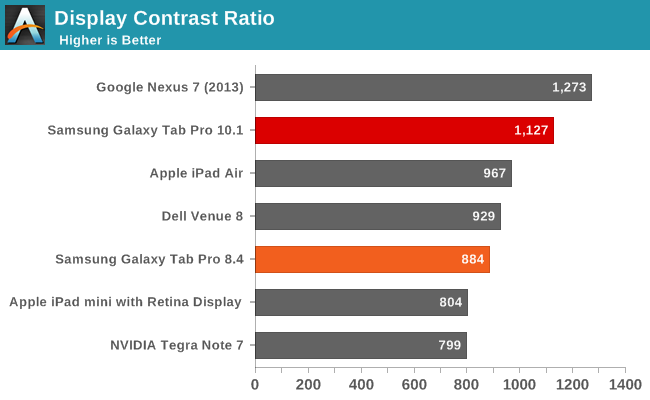
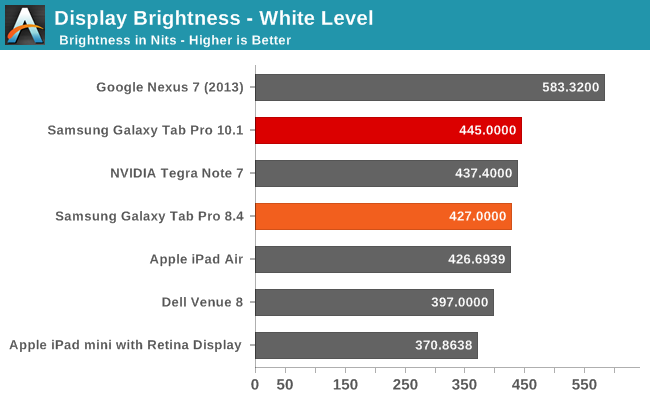
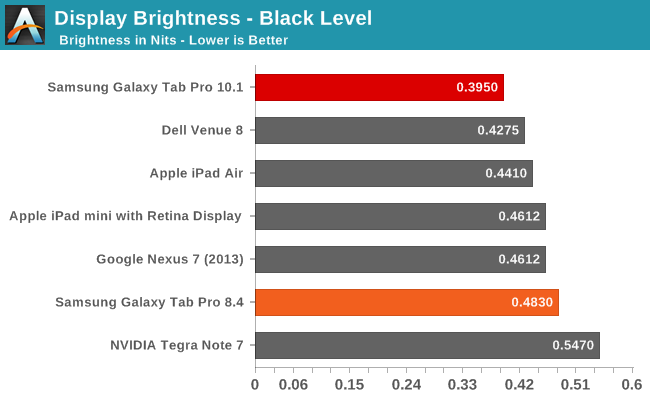
While none of the results are necessarily standouts (other than the grayscale dE 2000 on the Pro 10.1), we again have to keep in mind the fact that these are 2560x1600 panels in 10.1 and 8.4 inch devices. Factory calibration would push them over the top, but even without that they’re going to provide a wow factor to anyone used to lower resolution, lower quality displays.








































125 Comments
View All Comments
Death666Angel - Wednesday, March 26, 2014 - link
True, Apple devices sell for more on the 2nd market. But considering that they also cost usually 600€ or more (I remember a time when non-contract iPhones were 800€), you also pay a lot more up front. I've paid 500€ for a Galaxy S2 because I imported it from the UK and got it as one of the first in Europe. I ended up selling it for 180€ 18 months later. An iPhone would have cost me about the same (320€, taking the upfront price and subtracting the resell price). But that is a rubbish deal either way. I'm not going to spend more than 350€ for a phone these days. Resell value or not. And I also know a lot of people who have rubbish iPhones (mostly 4 and 4s) that keep rebooting randomly, have bad battery life, weird issues. They can't resell those for more than 50€. And they are all out of warranty of course. So really, you are making an anecdotal argument, that will only be true for some people and for a lot of others it won't.ESC2000 - Friday, March 28, 2014 - link
See my post below - just checked what the iPad 4 and the nexus 7 2013 would command on amazon and in both cases it was 65% of the MSRP. It makes sense that apple products from three years ago command more than android products from three years ago bc all apple products were better then but they aren't anymore so expect to see the resale values gap closing. There is still some downward pressure on the resale value of Android (and Windows) products bc there are more models and more devices period.Also anyone who would pay $350 for an iPhone 4 is just stupid, I'm sorry. I get platform dedication blah blah blah but when you could have a new nexus 5 for the same price it's time to let go of brand allegiance.
ESC2000 - Friday, March 28, 2014 - link
Btw I just went and checked amazon and either your price aren't representative or you're lying. Both devices on there are going for about $200 used (assuming the iPhone didn't have like 64 GB storage while the note had 16 or something). NEW iPhone 4s were going for $350. Nice try LOL. Here it is for everyone to see:http://www.amazon.com/Samsung-Galaxy-Note-SGH-i717...
http://www.amazon.com/Apple-iPhone-4S-16GB-White/d...
StrangerGuy - Saturday, March 22, 2014 - link
The only performance benchmark that only matters these days is the eMMC speed. Who cares about how much bazillion FPS in 3D when everything else stutters everywhere.UltraWide - Sunday, March 23, 2014 - link
So very true!jasonelmore - Monday, March 24, 2014 - link
and RAM. RAM dictates how long the device will be servicable and recieve updates. Apple's ipad line is gimped by their 1GB of RAM. They did it on purpose. 2 years from now, the device will start going slow because apple's 2014-2015 devices will all have 2GB or even 4GB of ram, which in turn, makes app developers use more of it. My ipad air's keyboard is stupidly slow to react to typing thanks to its horrible memory bandwidth on a almost 3 MP screen.akdj - Monday, March 24, 2014 - link
May wanna get it checked out. 7.1 made MASSIVE leaps forward with a 'brand new' rewrite of OS7. I've got three Airs and four iPad 4s. All are incredibly responsive, no crashing and fast as hell (we run an audio/video production company.ESC2000 - Tuesday, March 25, 2014 - link
Well then you are in the minority bc the three ipad air /retina ipad minis in my house regularly crash, a couple times a week, usually in safari. They also randomly reboot. I've teased my family about it bc my $230 nexus 7 (2013) is more reliable than their $400+ ipads. I've also sat them down next to each other and the screen and responsiveness of the nexus 7 matches the ipads despite being so much cheaper.I think the low amount of RAM in the ipads is contributing to the crashing. When I had an iPhone I was limited to eight tabs in safari which I assumed was bc it didn't have the internal memory to handle more. I've heard that the new ios update fixes the crashing and rebooting problem (which we know is real btw bc apple copped to it and claimed to be fixing it).
And the person who was claiming that all apple products have better resale value - that was true in the apple's edge is eroding. Three years ago apple products were objectively ahead of Android products so, fast fwd a few years to last year or this year when you're reselling them, and you see that apple products command a higher amount of money. But if you're talking about products released a year ago, Apple was no longer decisively the best phone or tablet manufacturer, so the gap has started to close. I just compared the price a used nexus 7 2013 and a used ipad 4 were going for on amazon and they were both going for around 65% of their original price.
Vigneshj - Sunday, March 23, 2014 - link
Will Samsung be releasing AMOLED display on tablet..? Watching movies/netflix can be a treat in AMOLED in large displays.StrangerGuy - Sunday, March 23, 2014 - link
Screw AMOLED? I'm far more concerned about the Pentile 2 subpixels per pixel shenanigans invading the LCD space here, from Samsung no less. I'm surprised the reviewer didn't even touch upon this.